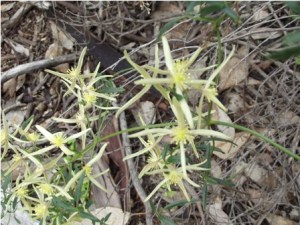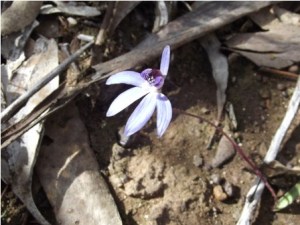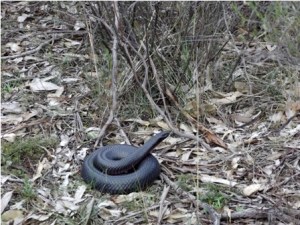The weather forecast was for sunny skies and 14C but the reality was another drab day with cool winds in the open. We met at Rushworth to drive in convoy to Gobarup, about 20kms to the south west. The road was full of promise as we spotted Greenhoods on the verges and Grass-trees on the hills.
We drove through a running shallow creek to reach Gobarup, an indicator of the wetter winter this year. These wetter conditions may have saved Gobarup this year as it is slated to be burnt in the push to burn 5% of our forests every year .To this end Don has written an objection to DSE , as has our Club, and other members may object by visiting the DSE website for information. As we parked a couple of canny members spotted the Small-leaved Clematis, shown above. In my urgency to get out of the car and into the bush, I missed the obvious next to the car ! Catherine had a rare plant lists for us, from information supplied by Don, copied from a previous visit by the noted Victorian botanist James Willis, of the Royal Botanical Gardens and Herbarium .They are printed below. The complete list was prepared by Jim Willis and subsequently printed in the Victorian Naturalist 1949 Vol 65.
| Cane Spear Grass | Stipa elegantissima |
| Variable Sword-sedge | Lepidosperma laterale(linerale) |
| Buloke | Casuarina luehmannii |
| Common Sour-bush | Choretum glomeratum |
| Bluebush | Maireana enahylaenoides |
| Whirrakee Wattle | Acacia williamsonii |
| Narrow-leaf Wax Flower | Philotheca (was Eriostemon) angustifolius |
| Small Crowea | Crowea exalata ssp revoluta |
| Dainty Phebalium | Phebalium obordatum |
| Scarlet Mint-bush | Prostanthera aspalathoides |
| Rough Mint-bush | Prostanthera denticulata |
| Coccid Emu-bush | Eremophila gibbifolia |
| Daisy Bush | Olearia decurrens |
| Wedge-leaf Hop-bush | Dodonea viscosa ssp cuneata |
| Bitter Cryptandra | Cryptandra amara |
Since Jim Willis visited this area, and after the studies he and other botanists have carried out over the years, some species have been re-assigned, had their names changed or been placed in other families. Some of the changes more recently have affected the names of some orchids so we need to be careful making assumptions as to what certain orchids are now named. .CSIRO have just released a USB stick with all the current info but at $120 I might wait a while before buying –maybe a local library may oblige.
This area is known for its mix of Blue and Bull Mallees, those distinctive multi-stemmed eucalypts which are rare in the Box/Ironbark Forest. The bushland was rich and varied and we were soon all looking down and spotting plants .Some of us were hoping to tick off some of the rarer types on the list .Flowering Cut-leaf Daisies were everywhere, vast swathes of Dodonea, the rare Whirrakee Wattle, Acacia williamsonii, still in full flower , Pycnantha in full flower, and the prickly Spreading Wattle .Then someone found the first Eremophila gibbifolia ,the Coccid Emu-bush, a low-growing and spreading form. There was much discussion over Mint-bushes but without flowers we couldn’t confirm some suspected plants. The more common Scarlet Mint-bush is found just to the north of here but later in the afternoon we couldn’t find that either. Another find was Variable Sword-sedge , listed as locally rare but we found it in abundance. Plenty of Dodder-laurel as well. Note was made of the amount of fallen timber providing excellent habitat for invertebrates, reptiles, small mammals and the like but the leaf litter load is very light. Much comment was made about the various types of funghi, plentiful and colourful, as well as the amount of different lychens. We moved on to eat our lunch and afterward, walk another slightly different area .
The lunch area was clearer and the different types of orchids in flower, or just about to, was amazing. Many of the Caladenia sp. of many different colours were seen. Emerging Leopard Orchids and Waxlips were also seen .
Other orchids that weren’t flowering couldn’t be named easily but in a week or two should be identifiable. There was an abundance of flowering Micromyrtus ciliata, the Heath-myrtle, plus Hibbertias, and Common Beard-heath. We even found a Tall Sundew in flower. Grevillea alpina, the creamy-greenish form, was seen close to the track too .Don led us to an open heathland , ringed by Red Box, Grey Box and Ironbark ,more typical of the Box/Ironbark country. A signicant amount of Ploughshare Wattle, Acacia gunnii , a sprawling prickly shrubby wattle , was in flower .We were possibly just a few weeks early for the major spring flowering here on the heathland but the area is beautiful.
All the while the birdoes amongst us were busy looking and listening, then taking notes. Flashes of colour had us looking for the Robins flitting around and we heard the call of the Grey Currawong. Despite what some of us thought as a slow day for birds, Peter with some input from others , compiled quite a good list –see below for the species seen on the day.
Collier and I spent quite some time looking at specimens of what we thought could be Daisy Bush , Olearia decurrens, rare enough not to have a common name ! After much looking and scrutinising, and looking carefully at Costermans we decided we had found Olearia decurrens, another plant on the rare list. This area also has an abundance of Common Sour-bush .Several other plants were unidentified, difficult to ascribe when not in flower and without a specialised botanical knowledge of this area.
As we drove out, my ever-vigilant navigator ( till she falls asleep) called me to stop. I backed up as Catherine had spotted a fine Red-bellied Black snake coiled next to the track.
We got a good look at the snake as it was getting cooler and it was probably a bit slow. I took several photos, one seen here. After leaving the Reserve, Don stopped for us to see some fine Melaleuca sp on the side of the road and spreading in to the nearby farmland. A bit further along we stopped to look for Scarlet Mint-bush but found Lemon Beauty-heads, plenty of Cassinia, one of the Myoporum sp and a spiny plant that could have been Spiny Bitter-pea .A bit further along we slowed to allow several quite large Eastern Greys to cross the road . Another wonderful day in a largely unknown area of the Box/Ironbark Forest –thanks Don for guiding us to this particular part .
Bird list for the day —thanks to Peter for the compilation.
-Common Bronzewing,
Wedge-tailed Eagle,
Galah,
Sulphur-crested Cockatoo
Musk Lorikeet
Little Lorikeet
Eastern Rosella
Red-rumped Parrot
Brown Treecreeper
White-throated Treecreeper
Superb Fairy-wren
Weebill
Spotted Pardalote
Striated Pardalote
Yellow-tufted Honeyeater
Fuscous Honeyeater
White-plumed Honeyeater
Brown-headed Honeyeater
Red Wattlebird
Black-chinned Honeyeater
Black-faced Cuckoo-shrike
Crested Shrike-tit
Gilbert’s Whistler
Rufous Whistler
Grey Shrike-thrush
Dusky Woodswallow
Australian Magpie
Grey Currawong
Grey Fantail
Willie Wagtail
Australian Raven
Restless Flycatcher
White-winged Chough
Jacky Winter
Flame Robin
Eastern Yellow Robin



